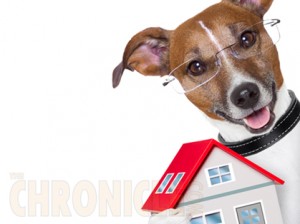Penn Vet: Helping Pets Cope with Quarantine, And Reopening
 Stay-at-home orders and social distancing mean many of people have been cut off from friends and family. But certain relationships have become more intimate amid the pandemic: those between people and their pets.
Stay-at-home orders and social distancing mean many of people have been cut off from friends and family. But certain relationships have become more intimate amid the pandemic: those between people and their pets.
Some people may believe that dogs relish their owners’ constant presence, while cats long for more alone time. The Wall Street Journal even satirized this belief in a column where a cat argues the side of reopening while a dog lobbies for continued closures. Other animal-lovers have taken advantage of the time at home to introduce a new pet into their families.
Carlo Siracusa, an expert in veterinary behavior at the School of Veterinary Medicine, notes that pets’ responses to increased togetherness aren’t necessarily species-specific, often tracing to individual differences. And the behavior of owners can either soothe or exacerbate their pet’s emotional state.
In a conversation with Penn Today, Siracusa shares insights into how quarantines may have affected animal behavior, how to keep pets’ stress levels down, and, as society begins to reopen, how to prepare cats and dog for more time apart.
What kinds of pet behavioral issues have cropped up due to the pandemic?
In general pets are very good at adjusting to their owners’ routines. What was happening when owners were away at work much of the day was that dogs and cats tended to use spaces that were ‘of the dog’ or ‘of the cat.’ The couch in the living room, for example, might have been the dog’s safe space. It was not just comfy, but he could also look out the window to see what was happening. So then, with the pandemic, now the owner comes in and is working on the couch, and the dog’s like, ‘What is wrong with you?’ This kind of situation might have generated some increased anxiety in the animal.
And it’s not just that we’re around. We are talking and we are listening to music or the news. We’re not just a presence; we’re sometimes an obnoxious presence.
There are people who are suffering as a result of the quarantine, too. They miss the quiet spaces of their offices. The difference is that humans are able to communicate and figure out a way to make it work. With a dog or cat it’s more difficult. They may communicate it but in a way that the owner might not understand.
For other pets—especially dogs—the situation may be reversed. They were suffering when the owner was away. Now the owner is around, and the dog’s like, ‘Finally, you are never going to leave me alone again!’ But then, if the owner goes back to work, it might cause the dog to have separation anxiety.
And one more thing for dogs. I suspect that when dogs go outside and interact with people, they may have trouble recognizing familiar faces when people wear masks. And now that people are social distancing, those neighbors who used to stop and give them a biscuit might not be doing that anymore. So, they may be picking up on how our behavior has changed as a result of the pandemic.
How much are these responses to our constant presence inherent to the different species, cats versus dogs?
There are obviously inherent differences, but I think a lot of it reflects human perception and expectation. That is, people who want a dog want a pet who is very present in their life. People who want a cat might want an animal that is more independent. So, it’s true to an extent, but it’s also what people project onto the species.
I think the most important thing is the pet’s individuality. So, even if most dogs are pro-quarantine, there are also individual dogs who are like, ‘When are you thinking of going back to work?’ And the same thing for cats, the opposite way.
There are also degrees of wanting togetherness. With my cat, for instance, right now she’s on the rug, near but not next to me. It’s a game of interactions.
What are some signs to look for that indicate your pet needs some space or time apart?
One of the first signs, and this is true for both dogs and cats, is a change in level of activity, in either direction. Some animals become more restless and nervously pace around. Owners might interpret this the wrong way—look my cat is here and wants to play—but really the animal might just be anxious.
Or, and this happens more often with cats, animals can decrease their level of activity. They may be thinking, I can’t go anywhere without bumping into someone so I’m just going to jump on the kitchen cabinet and stay there all day.
Another sign might be a change in vocalization. I’ve had clients complaining that their cats have been more vocal at night, for example, or their dog has been barking more. Part of this might also have to do with changes in the sleep-wake routine. If you’re going to bed later and sleeping later, that could lead to your pet vocalizing at times you think they shouldn’t.
You can also look at body language. You may notice your dog yawning or licking its lips. These are signs of nervousness. Cats, when you touch them, may become stiff. That’s a sign she’s not interested in that interaction.
In other cases, the animal’s stress can generate more serious problems, like aggression. I had a client who told me their cat used to be a very active animal but never aggressive but now was trying to bite people if they approached. In talking to this person we found that when the cat actually had some quiet time alone, its behavior would improve, and then the owner would try to pet it and it would bite again.
People think if you interact with your animal it’s going to destress you. Yes, that may be, but did you ask your pet how it felt? They can’t just be passive recipients for your needs.
If you start to see these signs that your animal is desiring more space, what should you do?
It’s important to set up times and spaces that they have to themselves. Part of this is trying to stick to a routine. Theoretically—and I understand it’s difficult—the routine should be as similar as possible to what you had before.
Then also you can set up spaces—and they might not necessarily be the same spaces the animal used to use—but spaces of equivalent value for your dog or cat to spend time. You can’t take the spot where there was good ventilation and then ask them to go to the basement where there is no air conditioning. Try to identify places where your dog and cat spends time and if they go there by themselves to be alone, then leave them alone. If you want to interact with them, call them, and let them decide if they’re ready for interaction.
Remember that before all this, our pets had six or eight or even 12 hours when we were gone during which their activity was very low. They still need their down time.
Now that certain businesses are reopening and more people are returning to work, what advice do you have for helping pets adjust to once again being on their own?
If you have an idea of when you’re going to go back to work, start to make the change gradual. You don’t want to go from seven days at home to five days in a row away if you can help it. Start to take longer periods of absence during the day. Start to promote independence: Try not to do things like play with your pet or take your dog for a walk at times you wouldn’t normally be home.
However, everything is very unpredictable right now, and not everyone is going to get a lot of notice when they go back to work. Most pets will adjust just fine. This is why they’re domestic animals because they’ve developed this capacity of communicating with humans and adjusting to humans’ schedules and needs. Even cats, though they’ve evolved from solitary animals, have learned to be social. The majority of dogs and cats will not have too many troubles.
But if you know that your animal is more sensitive to change, then you should be a little more careful. One thing we’re recommending to our clients is to have a camera in the home that can stream to their phone or computer so you can look in at what is happening to your animal when you’re not home.
Are there special considerations for people who took advantage of the time at home to adopt a new pet?
New pets have already gone through a stressful transition and are getting used to a new environment. Even in the best of circumstances, it might take weeks for them to adapt to a new home, and their stresses might be too subtle for the owner to perceive. The owner might think after two days that everything is going fantastic, and it might be some cases, but we see a lot of cases where it’s not.
For animals that are being fostered there are even more stresses. If people are getting a foster animal, I think it’s a great thing that they are giving this animal a chance, but they must be mindful that this is a stressful situation and that what happens in the foster home will have an influence on the animal’s future. If you’re fostering a dog and you don’t catch signs of stress and then this dog bites someone, it’s possible that it won’t have another chance at a home. So be mindful of the dog’s time and space. Do not put the dog in challenging situations.
How might Penn Vet’s new telehealth platform help with behavior problems that crop up during this time?
The new telehealth platform is not a substitute for pets that did have, before COVID-19, an important behavior problem that needs to be managed by a specialist. But for people who are seeing a change in their pet, seeing them suffering , either now or when they go back to work, they can talk to their veterinarian and their veterinarian can sign up for the service and consult with us.
Carlo Siracusa is an associate professor of clinical behavior medicine at the University of Pennsylvania School of Veterinary Medicine.
Short URL: http://caninechronicle.com/?p=186063
Comments are closed












